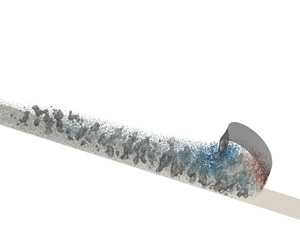Article contents
Turbidity currents propagating down an inclined slope: particle auto-suspension
Published online by Cambridge University Press: 09 January 2023
Abstract

The turbidity current (TC), a ubiquitous fluid–particle coupled phenomenon in the natural environment and engineering, can transport over long distances on an inclined terrain due to the suspension mechanism. A large-eddy simulation and discrete element method coupled model is employed to simulate the particle-laden gravity currents over the inclined slope in order to investigate the auto-suspension mechanism from a Lagrangian perspective. The particle Reynolds number in our TC simulation is  $0.01\sim 0.1$ and the slope angle is
$0.01\sim 0.1$ and the slope angle is  $1/20 \sim 1/5$. The influences of initial particle concentration and terrain slope on the particle flow regimes, particle movement patterns, fluid–particle interactions, energy budget and auto-suspension index are explored. The results indicate that the auto-suspension particles predominantly appear near the current head and their number increases and then decreases during the current evolution, which is positively correlated with the coherent structures around the head. When the turbidity current propagates downstream, the average particle Reynolds number of the auto-suspension particles remains basically unchanged, and is higher than that of other transported particles. The average particle Reynolds number of the transported particles exhibits a negative correlation with the Reynolds number of the current. Furthermore, the increase in particle concentration will enhance the particle velocity, which allows the turbidity current to advance faster and improves the perpendicular support, thereby increasing the turbidity current auto-suspension capacity. Increasing slope angle will result in a slightly larger front velocity, while the effect of that on the total force is insignificant.
$1/20 \sim 1/5$. The influences of initial particle concentration and terrain slope on the particle flow regimes, particle movement patterns, fluid–particle interactions, energy budget and auto-suspension index are explored. The results indicate that the auto-suspension particles predominantly appear near the current head and their number increases and then decreases during the current evolution, which is positively correlated with the coherent structures around the head. When the turbidity current propagates downstream, the average particle Reynolds number of the auto-suspension particles remains basically unchanged, and is higher than that of other transported particles. The average particle Reynolds number of the transported particles exhibits a negative correlation with the Reynolds number of the current. Furthermore, the increase in particle concentration will enhance the particle velocity, which allows the turbidity current to advance faster and improves the perpendicular support, thereby increasing the turbidity current auto-suspension capacity. Increasing slope angle will result in a slightly larger front velocity, while the effect of that on the total force is insignificant.
- Type
- JFM Papers
- Information
- Copyright
- © The Author(s), 2023. Published by Cambridge University Press
References
REFERENCES
- 7
- Cited by





